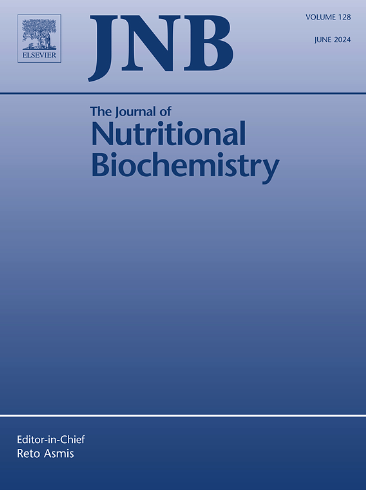TAS2R5 and TAS2R38 are bitter taste receptors whose colonic expressions could play important roles in age-associated processes
IF 4.8
2区 医学
Q1 BIOCHEMISTRY & MOLECULAR BIOLOGY
引用次数: 0
Abstract
Ageing disrupts how our bodies process nutrients, leading to deregulation of nutrient-sensing and increased inflammation. Dietary interventions can promote healthy ageing, which demonstrates the importance of both metabolism and the gastrointestinal tract for our health. Bitter taste receptors (TAS2R) present in the intestine are key members of metabolic regulation. TAS2R are involved in controlling enterohormonal secretion, detect phenolic compounds in our diet, and potentially have a great impact on the ageing process.
Here, we aimed to analyze the potential role of intestinal TAS2R on the ageing process and establish potential impact of these receptors on the biomarkers.
Healthy subjects were divided into two age cohorts: young (38.9±6) and aged (63.6±6). TAS2R expression was analyzed in the colon. Analyses of metabolomics and of phenolic markers were performed in plasma. Best discriminatory parameters were obtained using three machine-learning methods. Finally, Spearman's rank correlation was performed.
The best separators of the age cohorts were docosahexaenoic acid and multiple lipoprotein fractions. Two TAS2R were also identified: TAS2R5 and TAS2R38. TAS2R5 correlated with multiple lipoprotein-derived fractions, inflammatory marker IL-6 and polyunsaturated fatty acids. TAS2R38 was much more selective, correlating with a few parameters, including membrane lipid sphingomyelin, ketone body acetone, and omega acids. Both TAS2R5 and TAS2R38 correlated with β-hydroxybutyrate.
The parameters that correlated with TAS2R have known effects on the ageing process. This suggests that TAS2R5 and TAS2R38 are the bitter receptors most likely to play a role in the development and progress of ageing.
求助全文
约1分钟内获得全文
求助全文
来源期刊

Journal of Nutritional Biochemistry
医学-生化与分子生物学
CiteScore
9.50
自引率
3.60%
发文量
237
审稿时长
68 days
期刊介绍:
Devoted to advancements in nutritional sciences, The Journal of Nutritional Biochemistry presents experimental nutrition research as it relates to: biochemistry, molecular biology, toxicology, or physiology.
Rigorous reviews by an international editorial board of distinguished scientists ensure publication of the most current and key research being conducted in nutrition at the cellular, animal and human level. In addition to its monthly features of critical reviews and research articles, The Journal of Nutritional Biochemistry also periodically publishes emerging issues, experimental methods, and other types of articles.
 求助内容:
求助内容: 应助结果提醒方式:
应助结果提醒方式:


